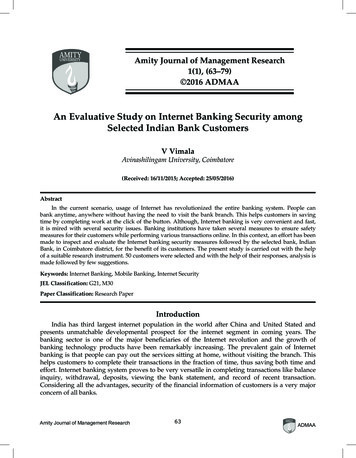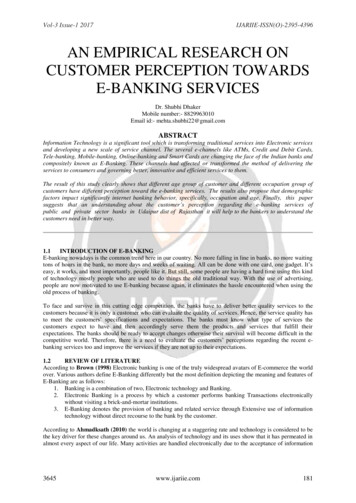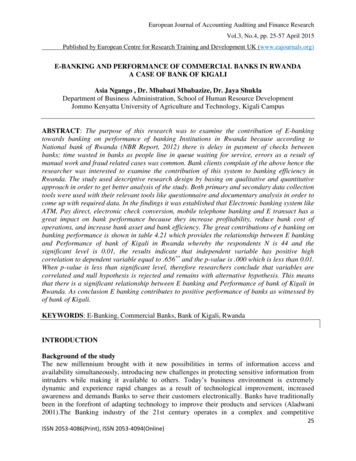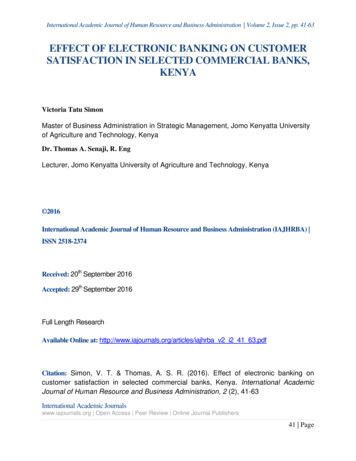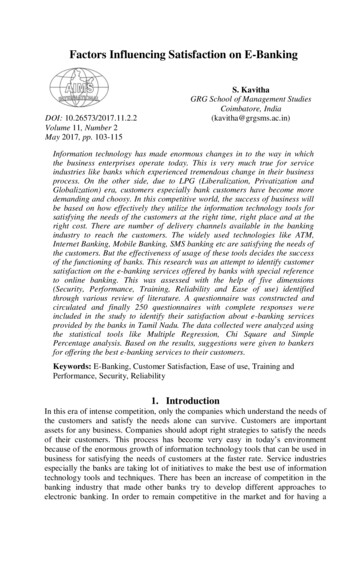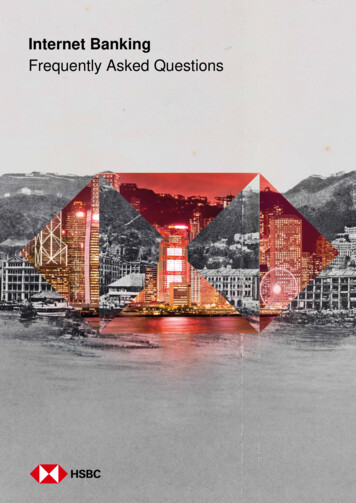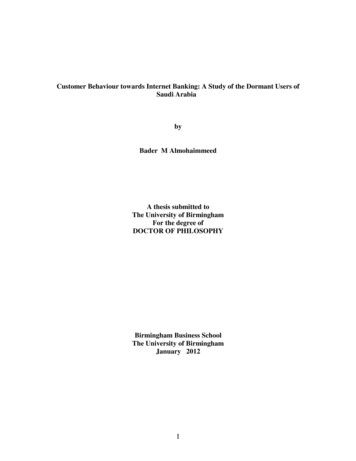
Transcription
Customer Behaviour towards Internet Banking: A Study of the Dormant Users ofSaudi ArabiabyBader M AlmohaimmeedA thesis submitted toThe University of BirminghamFor the degree ofDOCTOR OF PHILOSOPHYBirmingham Business SchoolThe University of BirminghamJanuary 2012I
University of Birmingham Research Archivee-theses repositoryThis unpublished thesis/dissertation is copyright of the author and/or third parties.The intellectual property rights of the author or third parties in respect of this workare as defined by The Copyright Designs and Patents Act 1988 or as modified byany successor legislation.Any use made of information contained in this thesis/dissertation must be inaccordance with that legislation and must be properly acknowledged. Furtherdistribution or reproduction in any format is prohibited without the permission ofthe copyright holder.
AbstractTechnology acceptance, especially internet banking acceptance has become a vital issuein the business world today. A number of studies agree on the importance of customeradoption and full utilization of internet banking services as the key factors for banks toachieve the benefits from launching this channel (eg. Guriting & Ndubisi, 2006; Nor,2005; Yousafzai, 2005; Mols et al., 1999). They also highlight the crucial role of thecomprehensive understanding of the factors and their interactions with each other thatinfluence customers in accepting and using internet banking services. A review ofliterature related to internet banking indicates that while there are numerous studies thathave tried to identify the factors affecting non-adopters and/or users of internet bankingthere is no single study, specifically in Saudi Arabia, that sheds light on the factorsaffecting dormant users of internet banking. Hence, the present study provides additionalinsights into this issue.The study adds to the body of knowledge in the technology acceptance field bydeveloping a comprehensive model for internet banking acceptance. The model extendedthe Technology Acceptance Model (TAM) to include additional components, namelytask-technology fit (TTF), perceived trust and perceived riskThe subjects for this study were Saudi bank customers who are dormant users of internetbanking services. One thousand copies of the questionnaire were distributed in five Saudicities: Riyadh, Jeddah, Dammam, Abhah and Buraydah. A total of 430 completedquestionnaires were received, giving a response rate of 43% of the original sample.Structural equation modelling (SEM) was the statistical technique employed in this study.The main results of this study suggest that two factors, namely perceived usefulness andservice visibility directly influence Saudi customers’ intention to use internet banking.Perceived ease of use is indirectly significant on the behavioral intentions throughperceived usefulness. Moreover, perceived trust, system reliability and accessibilitysignificantly influence perceived ease of use of internet banking. The results also revealthat customer trust in internet banking can be developed by focusing on only onetheoretical construct of trust, perceived bank trustworthiness of the internet bankingprovider. Based on the findings, implications for internet banking practice and relatedfuture research have been identified.II
AcknowledgementsI would like to take this opportunity to express my deepest appreciation and gratitude toall the people that have contributed to the completion of this thesis. First of all, I wish toexpress my thanks to my supervisors, Prof. Isabelle Szmigin and Dr. Louise Canning whohave supported and guided me throughout this academic journey. Acknowledgement alsogoes to Al Rajhi Bank and its customers who supported and participated in the research,which enabled me to complete this work.My family was the foundation of my strength and inspiration. I extend my deepestgratitude to my mother ‘Norah’ and my wife ‘Laila’ for their prayers, constant love,support and encouragement.Above all others, I thank Allah for providing me patience, guidance and perseverancethroughout this academic journey.Bader AlmohaimmeedOctober 2011III
Table of ContentsAbstractIIAcknowledgementsIIITable of contentsIVList of TablesIVList of FiguresIVList of AppendicesIVChapter One: Introduction1.1 Study Background11.2 Rationale for Research31.3 Research Objectives41.4 Research Questions51.5 Theoretical and Practical Value of the present Research71.6 Electronic Financial Services81.6.1 A Revolution in Electronic Finance81.6.2 Recent Trends in Financial Services and the Impact of IT1.6.2.1 Globalisation1212IV
1.6.2.2 Deregulation121.6.2.3 Consolidation131.6.3 Saudi Arabian Financial Sector141.6.3.1 Saudi Arabian Monetary Agency SAMA (The Central Bank)141.6.3.2 Commercial Banks in Saudi Arabia151.6.4 Internet Banking in Saudi Arabia161.7 Organisation of the Thesis19Chapter Two: Literature Review of Technology Acceptance Models2.1 Background252.2 Consumer Behaviour in the Context of the Financial Services Industry262.3 Innovation Diffusion Theory (IDT) and Perceived Attributes of Innovation (PIA)332.3.1 Criticisms of the IDT and PIA412.4 Theory of Reasoned Action (TRA)432.4.1 Criticisms of the TRA482.5 Theory of Planned Behaviour (TPB)492.5.1 Criticisms of the TPB542.6 Technology Acceptance Model (TAM)542.6.1 Attitude Construct in TAM58V
2.6.2 Perceived Usefulness and Ease of Use Beliefs in the TAM592.6.3 Dependent Variables of the TAM602.6.4 External Variables in the TAM612.6.5 The TAM Measurement Scales662.6.6 Review of Extended TAM Research672.6.7 Criticisms of the TAM752.7 The Task-Technology Fit (TTF) Model772.7.1 Dependent Variables of the TTF Model802.7.2 Dimensions of TTF812.7.3 Review of TTF Model Research81Chapter Three: The Role of Trust Relating to the Acceptance of InternetBanking3.1 The Importance of Trust in Electronic Finance903.2 Theoretical Perspectives of Customer Trust933.3 Definition of Trust983.4 Previous Research Related to Online Trust1023.5 A Conceptual Model of Trust for Internet Banking1073.5.1 Trust Antecedents108VI
3.5.2. The Relationships between the Antecedents of Trust1123.5.3. Consequences of Trust113Chapter Four: Internet Banking Research4.1 Factors Influencing non-adopters of Internet Banking4.2 Factors Influencing Users of Internet Banking1171254.3 Comparison between Users and Non-Users of Internet Banking1314.4 Satisfaction and Quality of Internet Banking Services1324.5 Limitation of Internet Banking Users’ Research1344.5.1 The Type of Subjects involved1344.5.2 The Theoretical Models Applied1354.5.3 The Issue of Perceived Trust and Perceived Risk138Chapter Five: Conceptual Development5.1 Rationale for Choosing TAM and its elaborating to include TTF and Trust Models1415.2 Conceptual model for Internet Banking Acceptance1445.2.1 Attitudes and Actual use Construct1465.2.2 Perceived Ease of Use and Perceived Usefulness147VII
5.2.3 Trust and Perceived Risk1485.2.4 Perceived Bank Trustworthiness1495.2.5 Perceived Structural Assurance of an Internet Banking Website1505.2.6 Integrated Trust with One of the TAM Beliefs1515.2.7 Integrated TTF Dimensions with TAM Constructs152Chapter Six: Methodology6.1 Research Philosophy1616.2 Research Design1666.3 Research Strategy1726.4 Research Method1916.4.1 Research Instrument1916.4.1.1 Questionnaire Development Process1926.4.1.1.1 Specify what Information will be sought1946.4.1.1.2 Type of Questionnaire and Methods of Administration1946.4.1.1.3 Developing Questionnaire Items1956.4.1.1.4 Form of Response to each Question2006.4.1.1.5 Determine Wording of each Question2006.4.1.1.6 Determine Sequence for Questionnaire2016.4.1.1.7 Determine Physical Characteristics of Questionnaire202VIII
6.4.1.1.8 Translation of Questionnaire2036.4.1.1.9 Pre-test Questionnaire and Revision2046.4.2 Sampling Procedure2066.4.2.1 Population2076.4.2.2 Sampling Frame2096.4.2.3 Determination of Sample Size2106.4.2.4 Sample Selection Method2116.4.3 Data Collection Procedure and Descriptive Results2126.4.4 Data Analysis Methods2176.4.4.1 Testing the Assumption of Normality2176.4.4.2 Transformation of Variables2186.4.4.3 Reliability and Validity2196.4.4.4 Structural Equation Modelling2226.5 Ethical Issues227Chapter Seven: Statistical Analysis7.1 Data Screening2287.1.1 Missing Data2297.1.2 Outlier Checks229IX
7.1.3 Normality2307.2 Assessment of the Measurement Model2367.2.1 Proposed Model2377.2.2 Revised Measurement Model2387.2.3 Final Measurement Model2437.3 Reliability and Validity of Constructs2497.4 Structural Model Evaluation2577.4.1 Proposed Structural Model2647.4.2 Revised Structural Model2687.5 Summary of the Findings278Chapter Eight: Discussion8.1 Explanatory Power of the Internet Banking Acceptance Model2818.2 Variables Embedded in the Technology Acceptance Model (TAM)2838.3 Variables Embedded in the Trust Model and their relationships with theTechnology Acceptance Model (TAM)2888.4 Task-Technology Fit’s Dimensions and their Relationshipswith the TAM Variables296Chapter Nine: ConclusionX
9.1 The Key Findings of this Research3049.2 Contributions and Theoretical Implications3069.3 Implications for Practice3139.4 Limitations of the Study3159.5 Future Research Directions3169.6 Summary320References322Appendices360XI
List of TablesTable 1.1: Middle East Internet Usage and Population Statistics17Table 1.2: Review of internet banking services provided by Saudi Banks19Table 2.1: Adopters’ Categories based on Innovativeness37Table 2.2: Summary of Selective Studies related to the Innovation Diffusion40Theory (IDT)Table 2.3: Summary of Selective Studies Related to the Theory of ReasonedActionTable 2.4: Summary of Selective Studies related to the Theory of PlannedBehaviour (TPB)Table 2.5: Summary of Selective Studies that Proposed External Variables asAntecedents of Perceived Usefulness and Ease of UseTable 2.6: Summary of Selective Previous Studies that Extended the TAMTable 2.7: Summary of Selective Previous Studies that Utilized Task-TechnologyFit (TTF) Model4753627286100Table 3.1: Review of Trust DefinitionsTable 3.2: Sources and Consequences of Trust Proposed in Previous StudiesRelated to E- commerce104Table 4.1: The Main Important Factors Influencing Non-Adopters of Internet123Banking Identified by Previous Studies.Table 4.2: The Main Important Factors Influencing Users of Internet Banking130Identified by Previous Studies.Table 6.1: Major Differences between Deductive and Inductive TheoriesXII168
Table 6.2: Differences between Qualitative and Quantitative Research Strategy174Table 6.3: New Items developed from the Focus Group Discussions190Table 6.4: The Operationalization of the Study’s Variables196Table 6.5: Reliability Coefficient for Scale Variables Used in this Study206Table 7.1: Univariate Normality Assessment for Study Variables (N 390)232Table 7.2: Chi-square Statistic and Fit Indices for the Revised Measurement241ModelTable 7.3: Items Deleted from the Measurement Model and Reasons for242Item DeletionTable 7.4: Chi-square Statistic and Fit Indices for the Final Measurement Model244Table 7.5: Standardized Item Loadings for the Final Measurement Model245Table 7.6: Reliability Indices for the Model Constructs (N 390)250Table 7.7: Convergent Validity Results for the Final Measurement Model (N 253390)Table 7.8: Discriminant Validity Results from Confirmatory Factor Analysis (N 256390)Table 7.9: Fit Indices for Competing Theoretical Models260Table 7.10: Chi-square Statistic and Fit Indices for the Proposed Structural Model266Table 7.11: Maximum Likelihood Estimates for Paths of the Proposed Structural267ModelTable 7.12Modification Indices for Non-Hypothesized Paths270Table 7.13: Chi-square Statistic and Fit Indices for Revised Model271XIII
Table 7.14: Maximum Likelihood Estimates for Revised Model272Table 7.15: Explanatory Power for the Endogenous Constructs in the Revised273ModelTable 7.16: Summary of Findings for the Present Study279Table 8.1: Summary of Findings for the Present Study Related to the VariablesEmbedded in the Technology Acceptance Model (TAM)285Table 8.2: Summary of Findings for the Present Study Related to the VariablesSuggested in the Trust Model and their Relationships with the Technology288Acceptance Model (TAM)Table 8.3: Summary of Findings for the Present Study Related to the TaskTechnology Fit’s Dimensions and their Relationships with the TAM variablesXIV299
List of FiguresFigure1.1: A Road Map to the Present Thesis23Figure 2.1: Consumer Behaviour Matrix (Beckett et al., 2000)29Figure 2.2: A Model of Product Chanel for Financial Services (Black et al.(2002)31Figure 2.3: Characteristics of Innovations (Moore & Benbasat, 1991)36Figure 2.4: Theory of Reasoned Action (Fishbein & Ajzen, 1975)43Figure 2.5: Theory of Planned Behaviour (Ajzen, 1991)49Figure 2.6: Technology Acceptance Model (Davis et al., 1989)55Figure: 2.7: The basic fit model (Dishaw &Strong, 1998a)87Figure 3.1: A proposed Model of Trust for Internet Banking (Source: ThisResearch)Figure 5.1: Conceptual Model for Internet Banking AcceptanceFigure 6.1: The Process of Deduction Theory108145167(Bryman,2001Figure 6.2: The Process of Abduction Theory (Fischer, 2000)Figure 6.3: Processes of Questionnaire Development (Source: based onChurchill, 1999)Figure 6.4: Demographic Profile of the Respondents (Source: This research)Figure 6.5: Internet Banking Experience of the Respondents (Source: Thisresearch)Figure 7.1: Normal P-P Plot of regression standardized residuals for thebehavioural intent model.170193215216236Figure 7.2: Model One (TAM)261Figure 7.3: Model Two (TAM plus TFF)262Figure 7.4: Model Three (TAM, TTF and Trust Model)263XV
Figure 7.5: The Proposed Structural Model and Significant Coefficients(solidlines)Figure 7.6: The Revised Structural Model and Significant Coefficients(solidlines)Figure 9.1: The Final Research Model265274308XVI
List of AppendicesAppendix 1: The Moderator’s Guide for Focus Group360Appendix 2: Main Points and Themes Raised During the Focus GroupDiscussionsAppendix 3: Comparisons between the Original and AdaptedMeasurement Items for the final scales363Appendix 4: The questionnaire consultation sent to academics andmanagersAppendix 5: Final Questionnaires (English copy)372Appendix 6: Final Questionnaire (Arabic copy)389Appendix 7: Overall Demographic Data of the Respondents397Appendix 8: Frequency and Percentage from Item Responses398Appendix 9: Data Screening401XVII365381
1. IntroductionChapter 1 presents the research background and the rationale for the research. It introducesthe reader to the objectives this study aims to achieve and highlights the theoretical andpractical value of the present study. The chapter also provides a brief introduction toelectronic financial services literature. Finally, the chapter presents the outline of the thesis.1.1 Study BackgroundA recent commercial phenomenon has been the growth in the use of the internet in allbusiness activities, particularly for financial services industries. Internet technologies haveessentially changed the way in which banks provide their services and customers conducttheir banking needs. One of these technologies, which has increasingly become a favoureddistribution channel by service providers and customers alike, is internet banking services(Haque, 2009). Internet banking is defined as ‘the use of the internet as a remote deliverychannel for banking services and internet banking is defined as a bank that offers (web-based)transactional services’ (Gopalakrishnan et al., 2003: p. 413). Internet banking as a bankingchannel allows customers to conduct all traditional banking services, such as making onlinebill payments, balance enquiry and fund transfer to other accounts without visiting their bankbranch.Internet banking research points out that banks which do not offer internet banking servicesare expected to lose more than 10% of their customers over the next five years because theircompetitive advantages in banking service delivery will erode (Tower Group, 2005). By1
providing internet banking services as an alternative delivery channel, banks seek to loweroperating costs by reducing their branch networks and downsizing the number of service staff,improve their banking services and customer satisfaction and retain their existing customers(Khalfan et al., 2006; Almogbil, 2005). Internet banking is considered as the cheapestdistribution channel for standardised bank operations (Polasik & Wisniewski, 2009). BoozAllen & Hamilton (2001), cited in Yousafzai, (2005), claim that an average paymenttransaction through the internet costs 0.01 US as compared with 0.02 US for a personalcomputer banking service, 0.027 US for an ATM service, 0.54 US for a telephone bankingservice and 1.07 US at a bank branch. From the customers’ perspective, this banking channelfacilitates a convenient and effective approach to manage personal banking needs, as it isaccessible 24 hours a day and 365 days a year from any location and without visiting a bankbranch (Rotchanakitumunai & Speece, 2003; Bruno, 2003).Banks cannot achieve the benefits of internet banking unless customers accept and fullyutilise its associated capabilities. Al-Gahtani & King (1999) state there will be little returnfrom technological developments if customers fail to adopt and fully utilise its capabilities.Technology acceptance, especially internet banking has become a vital issue in the businessworld today. Understanding customers’ requirements and meeting their demands andexpectations regarding internet banking has become a challenge for banks. Courtier &Gilpatrick (1999) recommend that banks must survey customers’ requirements on a regularbasis in order to understand the factors that can influence their intention to accept and fullyutilise internet banking services. Such understanding will help banks to build appropriatewebsites and strategies in order to encourage their customers to adopt and fully utilize theinternet banking channel.2
1.2 Rationale for ResearchPrevious studies agreed on the importance of customer acceptance and fully utilizing internetbanking services as the key factor in order for banks to achieve the benefits from launchingthis channel (Guriting & Ndubisi, 2006; Nor, 2005; Yousafzai, 2005; Mols et al., 1999).They also highlighted the crucial role of the comprehensive understanding of the factors andtheir interactions with each other that influence customers in accepting and using internetbanking. A review of the literature related to internet banking indicated that while there arenumerous studies that have tried to identify the factors affecting non-adopters (Guriting &Ndubisi, 2006; Gerrard et al., 2006) or users (Cheng et al., 2006), there is currently no studythat sheds light on the factors influencing customers who are dormant users of internetbanking. Moreover, most of the previous research that studied internet banking users’behaviour has not distinguished between heavy users and dormant users of internet banking.Users of internet banking tend to be treated as a homogeneous population. This might haveled to a generalisation of some factors that were not accurate and appropriate for both groups(heavy users or dormant users).Mearian (2001) claimed that most of the banks’ websites are accessed by huge numbers ofcustomers in the USA, however only a minority of customers have made online financialtransactions. Furthermore, recent private reports revealed by some Saudi banks have shownthat although a high number of Saudi customers have registered for their internet bankingservice as users, most of them rarely use this channel and only a few of them have fullyutilized its capabilities (Saudi Arabian Monetary Agency, 2009). As a result, in order toprovide additional insights into this topic, a comprehensive study is needed to focus more onthe factors affecting Saudi customers who are dormant users of internet banking services. In3
this study, dormant users of internet banking are defined as ‘bank customers who have alreadyregistered as users of internet banking channels, but who still use two other banking channels,i.e., branch banking, ATM or phone banking as the most frequent ways of conducting theirbanking services’. There are three issues which should be highlighted regarding thisdefinition. First, in the present study, the definition of dormant users of internet banking isbased on how frequently a customer uses internet banking compared with other bankingchannels. This definition is based on the suggestions provided by the marketing researchdepartment of the Al-Rajhi Bank, one of the leading banks of Saudi Arabia. According to thisdepartment, the majority of Saudi bank customers frequently utilise (heavy use) only twobanking channels, such as branch banking with ATM, or phone banking with ATM and otherbanking channels are rarely used (dormant use). Thus this study considers the customers whodo not utilise internet banking as one of the two most frequent channels for conducting theirfinancial services as dormant users of this channel. Second, this definition does notdifferentiate dormant users from heavy users based on the variety and number of bankingservices they access through the internet. This is because all bank customers are different interms of the variety and number of banking services conducted through different bankingchannels they utilise. The last issue is that the definition does not segment internet bankinguser categories (dormant and heavy users) based on their experience regarding the use ofinternet banking. This is because some customers may have two or three years experiencewith internet banking, but they are still considered to be dormant users of internet banking.1.3 Research ObjectivesThe overall aim of this research is to add to the body of knowledge in the area of technologyacceptance and to extend our knowledge of the factors influencing intentions towards the use4
of internet banking among customers who are dormant users of this channel. Consumer use ofinternet banking in Saudi Arabia is used as the vehicle to develop this knowledge, with thestudy designed to achieve the following objectives:1.To identify the factors affecting Saudi customers’ intentions towards the use ofinternet banking.2.To explain the interactions between those factors affecting the intentions towardsinternet banking use.3.To examine the role of Saudi customers’ trust with regard to the use of internetbanking.4.To examine how trust might be developed to increase the use of internet banking.5.To examine how the dimensions of task-technology fit influence behaviouralintention and perceived ease of use with regard to internet banking use.1.4 Research QuestionsThe framework for this study is based on the technology acceptance model (TAM) (Davis,1986), outlined in Chapters 2 and 5 because of its parsimony and the wealth of empiricalsupport for it (Agarwal & Prasad, 1999; Adams et al., 1992; Lin & Lu, 2000; Venkatesh et al.,2003; Phaal et al., 2006). Furthermore, in order to overcome the existing weaknesses of theTAM that have been observed in the present study, this research extends the TAM by5
including additional components, namely task-technology fit (TTF), perceived trust andperceived risk (see Chapter 5, Section 5.1, p: 141 for more detail). This study is intended toanswer the following research questions:1. What are the factors that directly influence Saudi customers’ intentions towards theuse of internet banking?2. What is the relationship between Saudi customers’ perception of usefulness andease of use of internet banking?3. How do these perceptions affect Saudi customers’ intention to use internetbanking?4. What is the main role of Saudi customers’ trust in internet banking acceptance?5. How might Saudi customers’ trust in internet banking be increased?6. Do the dimensions of task-technology fit have varied influences on behaviouralintention and perceived ease of use?7. Which of the task-technology fit dimensions has more influence on Saudicustomers’ intentions and their perceptions of ease of use?6
1.5 Theoretical and Practical Value of the present ResearchThis research makes a contribution to both theory and practice. From a theoretical viewpoint,the present research adds to the body of knowledge in five areas:1- Extending existing literature by identifying the factors influencing the acceptance ofinternet banking among banks customers who have already accepted this channel, butwho have not fully utilised its capabilities.2- Developing a comprehensive model which contributes to online customer behaviourliterature by extending the Technology Acceptance Model (TAM) to include the TaskTechnology Fit (TTF) model, perceived trust and perceived risk and applying them tothe context of internet banking.3- Extending existing literature by applying the developed model to Saudi customers.4- Contributing to the online trust literature by examining the role of customer trust in thecontext of internet banking and how it might be increased.5- Contributing to technology acceptance theories by showing the role of the tasktechnology fit’s dimensions in the acceptance of internet banking.Aside from theoretical values, identifying the factors affecting the acceptance of internetbanking and understanding the relationships between them will help banks, particularly inSaudi Arabia, to respond to their customers’ perceptions and address their customers’ needs.7
This can be achieved by building appropriate websites and formulating proper strategies inorder to encourage their customers to fully utilize the internet banking channel.1.6 Electronic Financial ServicesThe growth of the internet has dramatically changed the structure and nature of financialservices. It has affected financial systems by moving from restricted propriety systems toopen networks. The internet and related technologies have allowed financial providers todistribute their products and services through new channels, such as ATMs, telephone andinternet banking. The main aim of this section is to provide a brief introduction to electronicfinancial services literature. The section divides into four sub-sections. Section 1.6.1 presentsthe revolution of electronic finance. In section 1.6.2, recent trends in financial services and theimpact of IT will be discussed. Section 1.6.3 contains an overview of the Saudi Arabianfinancial sector and then internet banking in Saudi Arabia is presented in Section 1.6.41.6.1 A Revolution in Electronic FinanceElectronic finance is defined as ‘the provision of finance services and markets usingelectronic communication and computation’ (Allen et al., 2002: p. 5). The use of electronicfinance goes back much further than the 1970s, particularly in 1918 when the Fedwirepayment system allowed electronic settlement of payments between banks over the telegraph(Allen et al., 2002). This use of electronic communication in payment systems has steadilygrown over time. By the end of the 1990s, electronic finance technologies had certainlyinfluenced all aspects of the business of banking and financial intermediation. The internetand related technologies have allowed financial services to be distributed through newchannels, such as ATMs, telephone and internet banking. Therefore, providers, such as banks,can offer products and services without much human touch and at very low cost. Cronin8
(1998) states that the momentum of electronic finance has picked up substantially for fourreasons:(1) New distribution channel: the development of computer networks, such as the internethave enabled financial institutions to distribute their financial services and productsthrough channels such as the internet and has made it easier for customers to conducttheir banking services anywhere and anytime.(2) No barriers to entry: with technology advances, nonbanking firms have been able toprovide banking services. For example, in the area of bill payments, innovations haveprovided an opportunity for nonbanks, such as Checkfree, to break into the bankingbusiness.(3) Changing customer expectations forcing the need for agility and flexibility:technology innovations have not only enabled financial providers to produce a rangeof products, but they have also had far reaching effects on customers' expectations.Financial providers should understand that in order to meet customers' expectations,they need to be flexible by separating the content (financial product) from thedistribution channel (the branch) and agile enough to meet their customers' demands.(4) Digital convergence of financial management transactions:technology advanceshave allowed for a convergence of a broad range of financial management activities,which were previously disparate. By the end of the 1990s, diverse transactions, suchas bank, credit card and fund transfer were able to be conducted through one commoninterface. Therefore, a precondition for convergence was the need for communicationamong a wide range of financial institutions.9
Claessens et al. (2002), cited in Allen et al., 2002, reviewed the state of electronic financearound the world and highlighted that the developments can be divided into two broad areas.The first is the impact on banking and financial services. They stated that the advent of theinternet and other electronic communication means has fundamentally changed many aspectsof the banking industry. For example, a number of financial services which were traditionallyprovided by banks are being provided by other entities. The second broad area is thetransformation of the financial market. Due to the advances in technologies and the growth ofthe internet, these no longer need to be associated with a physical place. As a result mostfinancial services have become global, such as trading systems for equities, bonds and foreignexchange. All these changes have important impacts for public poli
Customer Behaviour towards Internet Banking: A Study of the Dormant Users of . Saudi Arabia . by. Bader M Almohaimmeed. A thesis submitted to. The University of Birmingham. For the degree of. . 3.4 Previous Research Related to Online Trust 102 3.5 A Conceptual Model of Trust for Internet Banking 107 .
